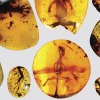The infant chameleon lived 99 million years ago.
You may have heard that a 15-million-year-old ancient poisonous flower was recently found perfectly preserved in amber, and now, an amber-fossilized lizard was found in Southeast Asia that dates back 99 million years — making it the oldest specimen of its kind.
The lizard is 78 million years older than the previous record holder, according to researchers at the Florida Museum of Natural History. The dime-sized lizard was found decades ago in a mine, along with 11 other ancient, well-preserved reptile fossils, but the Florida scientists were only able to analyze the specimens recently.
The infant chameleon became trapped by the resin of a coniferous tree in the ancient tropics of present-day Myanmar. Over time, the resin fossilized into amber, leaving the lizard perfectly preserved.
SEE ALSO: 4 Million Year Old Whale Fossil Discovered in Construction Site
Of the 12 lizard specimens, three — a gecko, an archaic lizard, and the chameleon — were particularly well preserved. These fossils hold snapshots of “missing links” in the evolutionary history of lizards, which should help scientists learn a lot more about them.
“These fossils tell us a lot about the extraordinary, but previously unknown diversity of lizards in ancient tropical forests,” Edward Stanley, a University of Florida postdoctoral student in herpetology at the Florida Museum of Natural History and co-author of a new study, said in a press release.
“The fossil record is sparse because the delicate skin and fragile bones of small lizards do not usually preserve, especially in the tropics, which makes the new amber fossils an incredibly rare and unique window into a critical period of diversification.”
Stanley first came across the amber fossils at the American Museum of Natural History after a private collector donated them. Although he knew the fossils were ancient, it was a combination of luck and micro-CT technology that allowed him to figure out the age of the chameleon.
“It was mind-blowing,” Stanley said. “Usually we have a foot or other small part preserved in amber, but these are whole specimens—claws, toepads, teeth, even perfectly intact colored scales. I was familiar with CT technology, so I realized this was an opportunity to look more closely and put the lizards into evolutionary perspective.”

Micro-CT scan of the oldest known fossil chameleon shows the hyoid bone highlighted in blue, which proves it had a projectile tongue like modern species. Photo credit: Edward Stanley/Florida Museum of Natural History
Using a micro-CT scanner, the researchers were able to look inside the amber without damaging the fossils inside. Instead, they were able to digitally piece together the tiny bones and see the internal soft tissue — providing insight into the anatomy and ecology of the ancient lizards.
For example, the scan showed that the lizard had advanced adhesive toe pads used for climbing, pushing back the origins of the group and challenging the long-held view that chameleons originated in Africa.
The chameleon also had the iconic projectile tongue of modern chameleons, but it had not yet developed the unique body shape and fused toes used by modern chameleons for gripping.
Stanley said the fact that these ancient lizards have modern relatives alive today speaks to the stability of tropical forests: “These exquisitely preserved examples of past diversity show us why we should be protecting these areas where their modern relatives live today.”
“The tropics often act as a stable refuge where biodiversity tends to accumulate, while other places are more variable in terms of climate and species. However, the tropics are not impervious to human efforts to destroy them,” Stanley continued.
The new species will be named and described in a future study.
Read next: Ancient Poisonous Flower Was Trapped in Amber for at Least 15 Million Years











Facebook comments